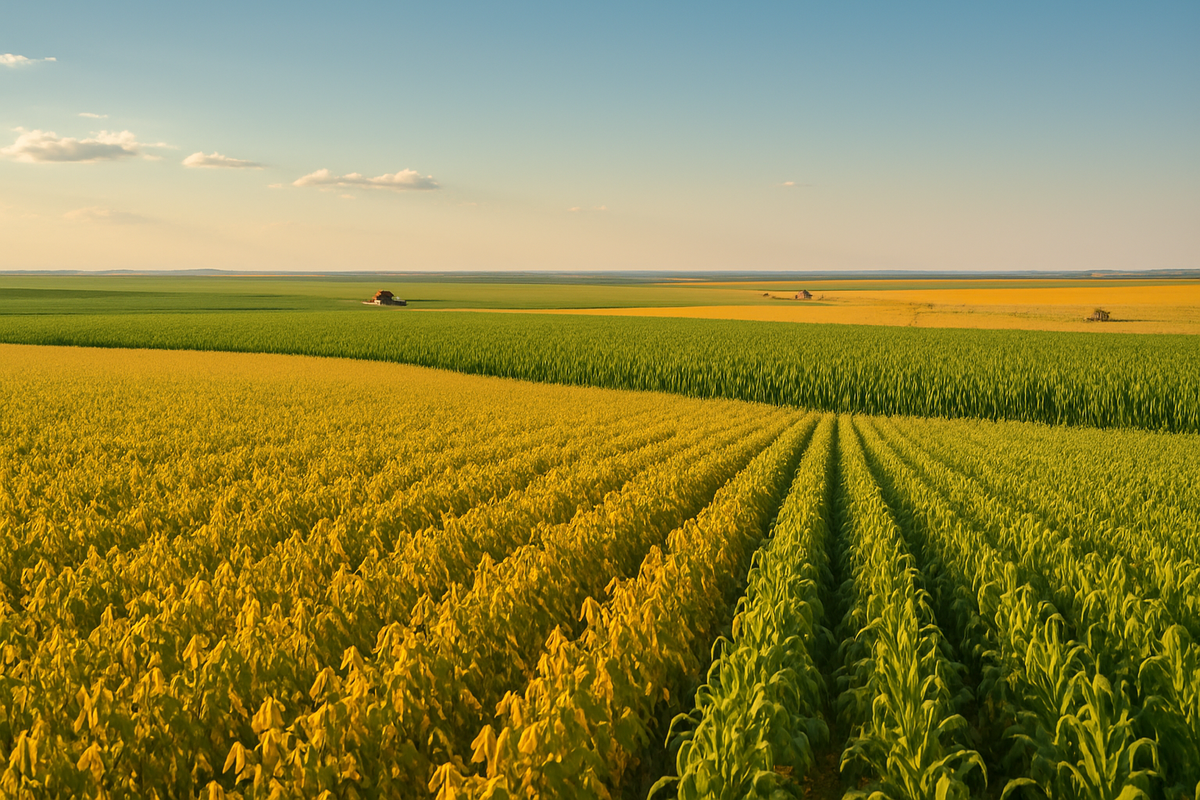
Brazil is gearing up for an unprecedented agricultural season, with projections indicating a record acreage planting for the 2025/26 crop season. This ambitious expansion, particularly in key commodities like soybeans and corn, is set to solidify the nation's position as a global agricultural powerhouse. However, this growth narrative is not without its complexities, as farmers are pushing forward with increased cultivation despite facing the challenge of low profit margins.
The immediate implications of this aggressive planting strategy are far-reaching. On one hand, it promises to bolster global food supply, potentially easing price pressures for consumers worldwide. On the other, it signals a highly competitive market environment for producers, both domestically and internationally, as a surge in output could further depress commodity prices. This paradoxical expansion, driven by robust global demand and strategic long-term investments, underscores the unique dynamics at play within Brazil's agricultural sector.
Unpacking Brazil's Agricultural Offensive: Specifics and Market Pulse
The sheer scale of Brazil's agricultural ambition for the 2025/26 season is striking. Forecasts from the National Supply Company (Conab) project a record soybean harvest of 177.64 million metric tons, an increase of approximately 6 million tons from the prior year. This surge is underpinned by an estimated 3.6% expansion in soybean acreage, reaching an astounding 49 million hectares (121.081 million acres). While some private consultancies like AgResource and Safras & Mercado offer slightly varying, but equally robust, figures, the consensus points to a significant increase in cultivation. Key states like Mato Grosso, Mato Grosso do Sul, and Bahia are at the forefront of this soybean boom, driven by the crop's continued profitability and favorable land availability, further bolstered by the recent increase in the mandatory biodiesel blend from B14 to B15, which fuels domestic demand for soybean oil.
Corn production is also set for a substantial season, with Conab estimating a total harvest of approximately 138.6 million tons. This comes from an expected 3.9% rise in total planted area, reaching 22.68 million hectares nationwide. Brazil's unique multi-crop system divides corn cultivation into three seasons: the first crop (summer corn), accounting for about 18% of the total, planted between August and December; the dominant second crop, or 'Safrinha,' contributing around 80% of total output, planted from December to March after the soybean harvest; and a smaller third crop in the Northeast. As of mid-October 2025, soybean planting was underway, with Paraná leading the charge, though farmers across most regions awaited consistent rains to accelerate operations. First-crop corn planting also commenced in September, setting the stage for the massive Safrinha corn planting to follow the soybean harvest.
Key players orchestrating and monitoring this agricultural expansion include governmental bodies such as Conab, which provides vital statistics and forecasts, and the Ministry of Agriculture and Livestock (Mapa), responsible for policy and financing through programs like the annual Harvest Plan (Plano Safra). Agricultural cooperatives, like those within the OCB System, are also pivotal, influencing policy, managing a significant portion of the harvest, and offering crucial credit to rural producers. Private consultancies, including AgResource, AgRural, and Safras & Mercado, offer independent analyses, contributing to a comprehensive market understanding.
Initial market reactions to these projections are a blend of anticipation and caution. While the record output reinforces Brazil's role as a dominant global supplier, it also portends downward pressure on international commodity prices, particularly on the Chicago Board of Trade (CBOT), raising concerns about tightening profit margins for producers already grappling with rising input costs. Brazil is expected to solidify its position as the world's largest soybean exporter, with Conab forecasting exports exceeding 112 million tons, potentially benefiting from shifts in global trade dynamics. Corn exports are also projected to grow significantly, reaching 46.5 million tonnes. Domestically, the burgeoning corn ethanol industry and increased biodiesel blending are expected to provide a crucial demand buffer, supporting internal prices. However, the looming threat of a La Niña weather pattern, with its potential for irregular rainfall and drought in southern Brazil, casts a shadow of uncertainty over the otherwise optimistic outlook, highlighting the inherent volatility of agricultural markets.
Corporate Fortunes in the Fields: Winners and Losers in Brazil's Agribusiness
Brazil's record-setting agricultural expansion for the 2025/26 crop season is poised to reshuffle fortunes across the agribusiness value chain, creating distinct winners and losers among public companies. The sheer volume of increased production, coupled with the persistent challenge of low farmer margins and infrastructural bottlenecks, will dictate the operational and financial performance of various industry players.
Agricultural input suppliers, encompassing fertilizers, seeds, and pesticides, are generally positioned to benefit from the increased acreage. Companies like ICL Group Ltd (NYSE: ICL), Nutrien Ltd. (NYSE: NTR), The Mosaic Company (NYSE: MOS), and Yara International ASA (OSE: YAR), all major players in the fertilizer market, are likely to see boosted sales volumes as more land is cultivated. Similarly, leading seed providers such as Bayer AG (ETR: BAYN), Corteva Agriscience (NYSE: CTVA), and local specialists like Boa Safra Sementes (B3: SOJA3) will experience higher demand for their high-yield and genetically modified varieties. Pesticide manufacturers like BASF SE (ETR: BAS) and FMC Corporation (NYSE: FMC) are also set to gain from the increased need for crop protection. However, the pressure on farmer margins could lead to intensified price competition, potentially compelling farmers to opt for cheaper alternatives or reduce application rates, thereby squeezing the profit margins of these suppliers despite higher volumes.
Grain traders, particularly global giants with extensive logistical networks, stand to gain from the massive increase in harvestable commodities. Companies such as Archer Daniels Midland (NYSE: ADM) and Bunge Global SA (NYSE: BG) are well-placed to capitalize on the higher volumes available for trading and export. Their ability to manage large-scale operations and navigate international markets will be crucial. Yet, the persistent logistical challenges within Brazil, including inadequate storage and a heavy reliance on road transport, pose significant hurdles. While increased supply might initially allow traders to acquire grains at favorable prices, the subsequent high costs and delays in moving these commodities to ports can severely erode profitability. Traders who have proactively invested in port capacity, rail connections, and private storage, especially along the burgeoning "Arco Norte" corridor, are expected to secure a competitive edge by mitigating these operational inefficiencies.
Brazilian food processors, which depend on domestic agricultural commodities as raw materials, could see a positive impact. Major players like JBS S.A. (B3: JBSS3), BRF S.A. (B3: BRFS3), and Marfrig Global Foods (B3: MRFG3), significant consumers of corn and soybeans for animal feed in their meat and poultry production, could benefit from a potentially abundant and cheaper supply of grains. This could translate into lower input costs and improved profitability, assuming stable demand for their end products. Additionally, companies like M. Dias Branco S.A. Industria e Comercio de Alimentos (B3: MDIA3) and Camil Alimentos SA (B3: CAML3), involved in processed foods and staples, could also see benefits. However, fierce competition within the food processing sector itself and fluctuations in global protein demand could temper the full extent of these gains. Finally, the chronic logistical bottlenecks present significant opportunities for related logistics companies. While specific pure-play agricultural logistics firms may not be publicly traded, general infrastructure and logistics providers, particularly those investing in new silos, expanding rail networks, or modernizing port facilities, will experience heightened demand. Companies that can offer efficient solutions to Brazil's storage deficit and transport challenges are poised for substantial growth, while those heavily reliant on less efficient road transport may continue to face margin pressures despite higher volumes.
Beyond the Fields: Broader Trends and Global Repercussions
Brazil's relentless agricultural expansion for the 2025/26 crop season is not an isolated event but rather a profound continuation of long-term industry trends that are reshaping global food and biofuel markets. This growth trajectory is fueled by persistent international demand for grains and oilseeds, coupled with escalating domestic biofuel mandates. The recent increase in Brazil's biodiesel blend from B14 to B15, effective August 1, 2025, is a significant policy driver, requiring an estimated additional 700,000 tonnes of soybean oil and further incentivizing soybean cultivation. While area expansion is evident, future growth is also increasingly reliant on efficiency gains, technological adoption, and substantial government support through programs like the "Plano Safra," which allocates billions in subsidized loans despite concerns over interest rates and regulation. This ambitious growth, however, unfolds against a backdrop of declining farmer margins, a challenge that could temper the pace of future acreage expansion.
The ripple effects of Brazil's agricultural offensive will be felt across the globe, particularly by its competitors and partners. The United States, a traditional agricultural rival, faces intensified competition as Brazil projects record soybean exports, potentially exceeding 112 million tons. With the U.S. potentially reducing its soy exports amidst trade tensions with China, Brazil is poised to further cement its position as the dominant global supplier, leveraging cost advantages and growing market influence. Similarly, robust Brazilian corn output has already begun to slow U.S. corn exports. Argentina, another South American agricultural power, will also experience competitive pressure from Brazil's expanding dominance. On the partnership front, China remains Brazil's largest customer for soybeans, with imports from Brazil increasing. This strong Chinese demand, combined with Brazil's record output, could lead to logistical strain at Brazilian ports as soybean and corn exports compete for capacity. Brazil's increased corn production may also prompt it to explore new markets in regions such as Iran, Egypt, and Vietnam.
Regulatory and policy implications are central to understanding the long-term trajectory of Brazilian agriculture. A critical point of discussion revolves around the future of the Soy Moratorium, a landmark 2006 agreement that prohibits the sale of soybeans grown on Amazon land deforested after July 2008. The potential termination or increased flexibility of this moratorium could unlock significant new areas for soybean cultivation as early as 2026, fundamentally altering the sector's outlook. Environmental licensing reform, currently under Senate review, also aims to streamline regulations, potentially facilitating infrastructure projects that would indirectly support agricultural expansion. Concurrently, Brazil is emphasizing sustainable agriculture, highlighted by its climate adaptation policies submitted to the UNFCCC in October 2025, and the potential to expand soybean production by repurposing degraded pastureland, aligning growth with environmental stewardship.
Historically, Brazil's agricultural ascent, particularly since the 1970s, has been a story of continuous expansion and modernization, driven by institutions like EMBRAPA and significant investments in tropical agricultural research. The dramatic expansion of soybeans from 1973 onwards transformed vast regions like the Cerrado, turning previously "unfit" soils into highly productive farmland through technological advancements. This historical context underscores Brazil's proven capacity for agricultural innovation and growth. However, recurring logistical challenges have also been a constant companion to record harvests. Past seasons, such as the 2022 grain crop, revealed significant storage deficits and transport bottlenecks, demonstrating that infrastructure development has often lagged behind production increases. This historical precedent suggests that the record 2025/26 crop will once again test Brazil's transportation and storage networks, potentially impacting export efficiency and domestic prices, and highlighting the enduring need for sustained investment in agricultural infrastructure.
The Road Ahead: Navigating Brazil's Agricultural Future
The 2025/26 crop season, with its projected record acreage and output, places Brazil at a critical juncture, presenting both immense opportunities and significant challenges for its agricultural sector. In the short term, the sheer volume of anticipated harvests will likely lead to an abundant global supply, exerting downward pressure on international commodity prices, particularly for soybeans. This, coupled with persistent high input costs for farmers, is expected to result in significantly tighter profit margins, potentially leading to financial strain for some producers. The already burdened logistical infrastructure—ports and transport systems—will face immense pressure, risking bottlenecks and increased transportation costs during peak harvest seasons. Furthermore, the potential for a La Niña weather pattern introduces volatility, threatening regional droughts in the south and excessive rains elsewhere, which could impact yields and overall production stability.
Looking further ahead, Brazil is poised to solidify its global market dominance, particularly as the largest soybean exporter, benefiting from ongoing trade realignments between the US and China. A long-term trend towards vertical integration and increased domestic processing of soybeans, driven by the expanding biodiesel mandate and livestock feed demand, will enhance Brazil's position in both internal and international markets. Sustaining this growth, however, necessitates substantial and continuous investment in infrastructure, including improved transportation networks and port capacity. The sector is also undergoing a technological transformation, with the adoption of advanced solutions like AI and biotechnology expected to boost yields, reduce pesticide use, and enhance climate resilience. Yet, these advancements must contend with the long-term impacts of climate change, which is already affecting agricultural productivity in central Brazil and demands a greater focus on sustainable land management and reduced deforestation.
To navigate these complexities, strategic pivots and adaptations are imperative. Farmers will need to adopt robust risk management strategies, including crop diversification and hedging against price volatility, to protect their tight margins. For the sector as a whole, prioritizing investments in sustainable practices, such as no-till farming and the recovery of degraded pastureland, is crucial for long-term viability and to mitigate environmental impacts, rather than expanding into new natural biomes. Continued investment in logistics, including roads, railways, and port facilities, is non-negotiable to efficiently handle increasing harvest volumes. Furthermore, ongoing research and development in resilient crop varieties and precision agriculture will be vital for adapting to climate change. Government policies, like the Plano Safra, must evolve to provide accessible credit, support sustainable practices, and address the specific needs of family farmers. Diversifying export markets beyond key players like China and focusing on value-added products can also reduce market reliance and mitigate risks from trade disputes. Crucially, careful policy decisions regarding the "Soy Moratorium" in 2026 will be essential to balance economic development with environmental preservation.
The market opportunities lie in the continued strong global demand for soybeans, particularly from China, and the robust domestic biofuel market. Increased domestic processing capacity for soybeans also presents opportunities for value-added products. However, significant challenges loom, including commodity price volatility, high production costs, persistent logistical bottlenecks, and the unpredictable nature of climate risks. Geopolitical tensions could disrupt export markets, and increasing environmental scrutiny demands a shift towards more sustainable practices. Potential scenarios range from an optimistic outcome of high yields, strong demand, and an adaptable sector efficiently managing its output, to a challenging scenario of oversupply, depressed prices, and logistical failures leading to farmer distress. A transformative scenario, where the sector strategically adapts towards sustainable intensification and diversified, environmentally responsible growth, represents a crucial aspiration for Brazil's agricultural future, balancing economic prowess with ecological stewardship.
A Harvest of Challenges and Opportunities: The Brazilian Agricultural Outlook
Brazil's 2025/26 crop season stands as a testament to the nation's agricultural might, characterized by record acreage planting and robust production forecasts for key commodities like soybeans and corn. This expansion solidifies Brazil's position as a global leader in food and biofuel production, yet it is a narrative interwoven with complexities, demanding strategic navigation from all stakeholders. The key takeaways from this season underscore a relentless drive for growth, fueled by strong global demand and domestic biofuel mandates, but tempered by the persistent challenge of tightening farmer profit margins. The impressive scale of soybean and corn cultivation, alongside significant output in cotton and a strategic shift in sugarcane towards sugar production, paints a picture of a dynamic and responsive agricultural sector.
Moving forward, the market will likely be defined by robust production potential clashing with increasing global supply. Brazil is poised to maintain its dominance in soybean exports, with China's continued reliance on Brazilian supplies reshaping global trade landscapes. The evolving corn market, driven by the burgeoning domestic corn ethanol industry, suggests a structural shift that could stabilize internal prices. However, the overarching concern remains profitability; abundant global supply for soybeans is expected to depress international prices, further squeezing farmer margins already pressured by rising input costs and higher financial expenditures. The strategic choice of sugarcane mills to prioritize sugar over ethanol due to attractive international prices also highlights the sector's adaptability to global market signals.
The significance and lasting impact of this season are profound. Brazil's consistent record harvests are crucial for global food security and underscore its escalating influence on international agricultural trade. The structural growth of the corn ethanol industry represents a pivotal domestic transformation, creating new demand avenues and potentially buffering commodity price volatility. Crucially, the continuous agricultural expansion brings environmental scrutiny, particularly concerning deforestation, pushing for a greater emphasis on sustainable practices and efficiency gains rather than solely on area expansion. Initiatives like the Responsible Commodities Facility (RCF) demonstrate a proactive approach to sustainable growth, aiming to incentivize zero-deforestation soy cultivation.
For investors, the coming months demand a vigilant eye on several critical factors. Weather patterns, especially the potential for a La Niña phenomenon, will be paramount, as adverse conditions could significantly impact yields. Global commodity prices will dictate farmer profitability, making global demand-supply dynamics a key watch point. Currency fluctuations of the Brazilian Real will influence export competitiveness and foreign investment. The evolution of input costs and farmer margins will directly affect the financial health of the sector. Furthermore, shifts in global trade policies, particularly between the US and China, could reshape export volumes. Lastly, sustained investment in logistics and infrastructure, alongside the continued evolution of the biofuel market, will present both opportunities and challenges for various segments of the agribusiness value chain. Navigating these intertwined factors will be key to understanding the trajectory of Brazil's powerful agricultural engine.
This content is intended for informational purposes only and is not financial advice





